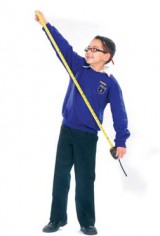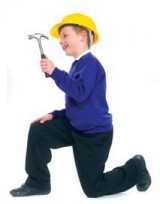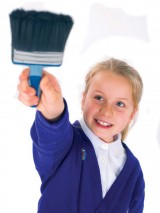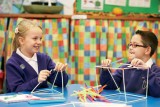If you want to develop your practical expertise in D&T and make learning in your classroom even more rewarding, Shropshire Education Advisor
How broad is the curriculum in your school? I think it is true to say that despite the relentless focus on English and maths in recent years and the squeezing effect this has had on the rest of the curriculum, most primary schools plan to carry out a wide range of interesting and motivating learning experiences in Key Stages 1 and 2. Perhaps a more important question is whether all the activities planned across the curriculum are fully translated into practice. Is the curriculum in your school broad and balanced on paper but rather less so in reality?
 If the answer is ‘yes’ then you are certainly not alone. Everyone working in the primary phase knows that significant external pressures and demands on schools have made it difficult to achieve breadth and balance. However, as nearly all primary practitioners are non-specialists, one further factor appears to be the range and depth of teachers’ subject knowledge and expertise. When equipped with sufficient expertise, even the trickiest, most unmanageable units of work can become possible. Expertise within a subject enables us to ‘get under its skin’, focusing children’s learning on what is essential, unique or important and shaping activities so that they work well within the time and resources available. According to the Cambridge Primary Review’s final report, even though the current National Curriculum may be overloaded with content, evidence suggests that there is nothing inherently unmanageable about it and in all the talk about curriculum manageability “one possibility is rarely mentioned: that the problems may relate to expertise as well as logistics.”(p.244)
If the answer is ‘yes’ then you are certainly not alone. Everyone working in the primary phase knows that significant external pressures and demands on schools have made it difficult to achieve breadth and balance. However, as nearly all primary practitioners are non-specialists, one further factor appears to be the range and depth of teachers’ subject knowledge and expertise. When equipped with sufficient expertise, even the trickiest, most unmanageable units of work can become possible. Expertise within a subject enables us to ‘get under its skin’, focusing children’s learning on what is essential, unique or important and shaping activities so that they work well within the time and resources available. According to the Cambridge Primary Review’s final report, even though the current National Curriculum may be overloaded with content, evidence suggests that there is nothing inherently unmanageable about it and in all the talk about curriculum manageability “one possibility is rarely mentioned: that the problems may relate to expertise as well as logistics.”(p.244)
Is your confidence low when teaching a particular subject that requires a high level of specialist or technical knowledge? How do you feel about teaching music, PE, art and design or D&T? Naturally, we all have areas of the curriculum where we feel more or less confident, and without a radical (and probably controversial) change to a specialist or semi-specialist teaching model this is likely to continue to be the case. A pragmatic way forward might be to ask how we can acquire the necessary subject knowledge and skills to feel sufficiently confident to teach at a good standard across the curriculum, without necessarily being an expert in everything.
According to Ofsted’s 2009 report Improving primary teachers’ subject knowledge across the curriculum, the best teaching showed that teachers understood the particular demands of individual subjects in relation to children’s learning. Children also place considerable importance on teachers’ subject expertise. Evidence given by children to the Cambridge Primary Review (p.148) about what makes an effective teacher paints a very clear picture. As one of a range of characteristics, they expected teachers to ‘really know their stuff’, to be able to give clear, understandable explanations, to have lots of energy and enthusiasm, and to give them help when they were stuck.
When researchers from a range of studies have asked primary aged children what their favourite subjects are they usually choose those which are hands-on, physical or practical, such as PE, art and design or D&T. Interestingly, the popularity of D&T carries on after Y6 and is pupils’ favourite option at GCSE. In primary schools we know that children love the practical aspects of D&T. Again this is backed up by research which finds that ‘making’ is their favourite part, but only if activities are well organised and if there is enough time for them to carry out their designing and making to a successful conclusion. There is nothing more frustrating for the children (or the teacher) than getting to the end of term with a partly completed product, or one which doesn’t work.
 The reality is that opportunities for teachers to attend CPD courses in the non-core subjects have been relatively scarce in the last ten or fifteen years and this situation looks unlikely to improve in the near future. In the case of creative and practically based subjects, like D&T, this can be a particular problem because you really do need the hands-on experience that effective CPD provides in order to have the confidence to carry out technically demanding activities with your class.
The reality is that opportunities for teachers to attend CPD courses in the non-core subjects have been relatively scarce in the last ten or fifteen years and this situation looks unlikely to improve in the near future. In the case of creative and practically based subjects, like D&T, this can be a particular problem because you really do need the hands-on experience that effective CPD provides in order to have the confidence to carry out technically demanding activities with your class.
In spite of this lack of training, the tenacity and resourcefulness of the profession has ensured that the teaching of D&T in primary schools has improved markedly in recent years. According to Ofsted’s 2009 report, nearly all the D&T teaching they sampled was good or outstanding. So how was this remarkable outcome achieved? The answer is that teachers piloted and rehearsed making activities themselves as part of their preparation for lessons, so they gained a better understanding of the difficulties that children might encounter. In short, ‘do-it-yourself’ CPD.
To support this school-based approach to developing practical skills and techniques, the Design and Technology Association is launching the Let’s Get Practical! campaign at this year’s Education Show. The campaign aims to help all primary teachers by pinpointing existing resources from a range of sources – some of which are freely available – that offer useful tips and inspirational ideas for practical work in the classroom. Some of the resources are intended for teachers own use whilst others are designed to support the demonstration and modelling of practical skills and techniques. The resources cover not only the skills needed for making but also the skills needed for 3D designing – such as developing paper mockups, pattern pieces or initial prototypes.
1. 120 technology techniques
 At the top of the list amongst freely available materials must be the Staffordshire STEP resources. This set of over 120 downloadable A4 resource sheets was originally published by Cambridge University Press in conjunction with the D&T advisory team from Staffordshire. In keeping with all the resources identified by Let’s Get Practical! each card provides visual, easily accessible techniques, skills and know-how covering an incredibly wide range of D&T topics. In fact everything from pulleys to paper straws to printing! This amazing resource can be found on Staffordshire Council’s website education.staffordshire.gov.uk. Using the side menu, select ‘Curriculum’, ‘Subject areas’, ‘Design & technology’, ‘Primary’, ‘Support’ and finally ‘Datafile’.
At the top of the list amongst freely available materials must be the Staffordshire STEP resources. This set of over 120 downloadable A4 resource sheets was originally published by Cambridge University Press in conjunction with the D&T advisory team from Staffordshire. In keeping with all the resources identified by Let’s Get Practical! each card provides visual, easily accessible techniques, skills and know-how covering an incredibly wide range of D&T topics. In fact everything from pulleys to paper straws to printing! This amazing resource can be found on Staffordshire Council’s website education.staffordshire.gov.uk. Using the side menu, select ‘Curriculum’, ‘Subject areas’, ‘Design & technology’, ‘Primary’, ‘Support’ and finally ‘Datafile’.
2. Easy reference help sheets
The Design and Technology Association has itself produced resources that can make a major contribution to the Let’s Get Practical! initiative. By far the most affordable and wellknown of these is the pack of D&T help sheets. This superb resource is intended for all primary teachers, providing ‘instant CPD’ through a folder of loose-leaf A4 cards, with sketches of processes and techniques for all of the QCA D&T units of work. The publication is so successful - it has sold in excess of 17,000 copies - because it assumes no prior knowledge, clearly explains technical vocabulary and is quick to read for the busy classroom teacher. Visit the online shop at data.org.uk for more details.
3. Practical posters
As part of Let’s Get Practical!, primary members of the D&T Association will also benefit from new A2 classroom posters which teachers can use with children to develop their know-how and skills using low cost materials and components. Each term, members can also access new PowerPoint presentations to develop their practical expertise and to support the teaching of new techniques to children. These new resources will also be very helpful for D&T subject leaders and co-ordinators who are organising their own workshops for colleagues in school. The Design and Technology Association is always on the look out for new resources to promote under Let’s Get Practical! Please get in touch with Julie Lunt .(JavaScript must be enabled to view this email address) if you have inspiring ideas or tips to share from your own practice or if you have discovered a resource in any aspect of D&T that could help teachers across the country to develop their practical expertise.
 Work together to create continuity…
Work together to create continuity…
If all the children in school, from EYFS to Y6, design and make the same type of product within a term – such as a bag, moving greetings card or toy vehicle – this can be a really good way to bring staff together to learn the practical skills and techniques they need. It also helps to build confidence and has the advantage that everyone has to work together to ensure that the products children create become progressively more complex throughout the school. For instance, bags in KS1 might generally consist of two identical pieces of fabric, whereas in Y3/4 children could assemble their product by folding up, sewing and fastening a single fabric shape, and in Y5/6 children could design and make their bag from a combination of different fabric shapes.
 Remember these pointers when demonstrating skills and techniques…
Remember these pointers when demonstrating skills and techniques…
It is really important to invest enough time in showing your class how to use tools and techniques safely and correctly. Here are some top tips for ensuring that whole class demos run smoothly:
Rehearse – make sure you have had a go yourself before demonstrating new skills to the class.
Be organised – ensure the tools, equipment and materials you need are easily to hand.
Think about timing – to maintain children’s interest make sure the session is not overlong and is as interactive as possible.
Keep children’s attention – let pupils know that you will be asking for volunteers to demonstrate to the rest of the class.
Use a visualiser – this ‘camera on stick’ can be useful for showing a whole class new techniques on the interactive whiteboard.
Don’t forget left-handers – where necessary, make sure that your demonstrations are suitable for both left-handers and right-handers.
Ensure consistency – make sure that TAs and other adults working in your classroom are up-to-speed with the tools and equipment you will be using.
Brush up on vocabulary – children will enjoy learning new technical terms so make sure you are confident about the specialist vocabulary you will be using.
The benefits of D&T association membership…
The D&T Association now has the second largest membership of all the subject associations in the UK. Primary membership has grown significantly in recent years with members enjoying low-cost regular CPD through a range of services including downloadable teaching resources, termly specialist magazines featuring new project ideas, as well as conferences, face-to-face training events and individual phone and email advice. For more details visit data.org.uk or contact Deborah Watson .(JavaScript must be enabled to view this email address)
Easy ways to combat teacher stress
Ace-Heads
How Financial Education Helps Children
Ace-Classroom-Support
